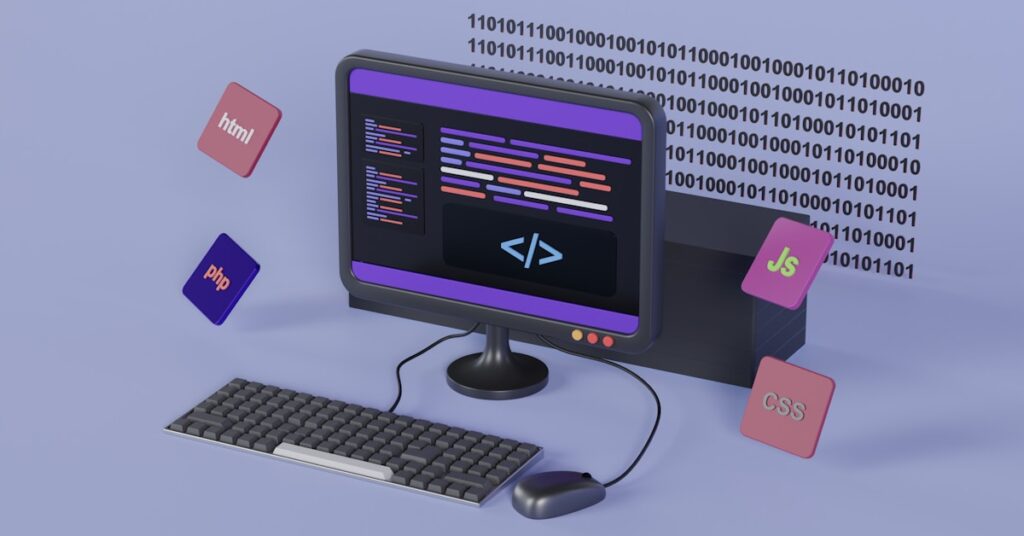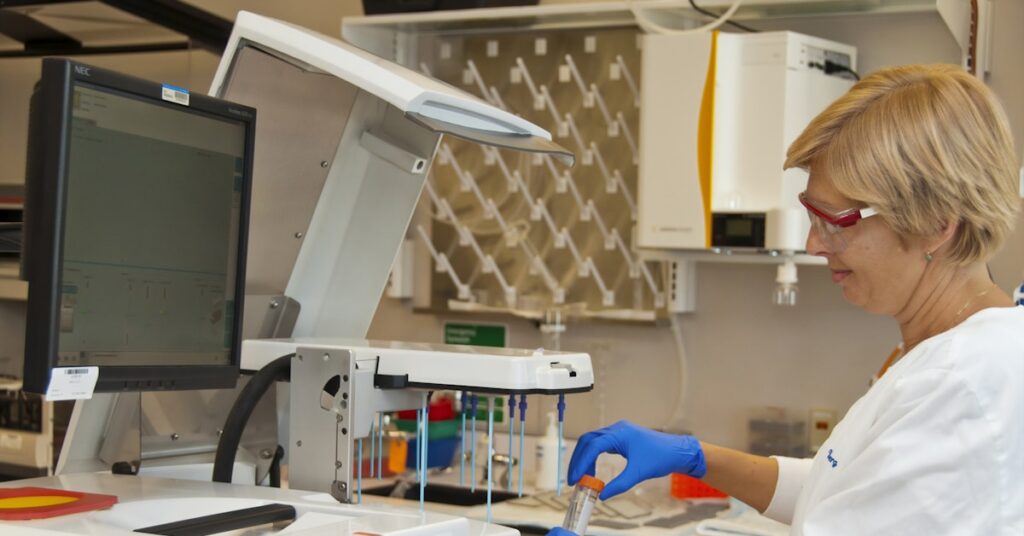Can you actually trust your reports?
You’re pulling numbers from spreadsheets, CRMs, and other apps. It’s a constant struggle to get a clear picture of what’s really happening.
The real problem is making critical decisions with outdated or incomplete information. This guesswork leads to missed opportunities and costly mistakes for your business.
This manual reporting cycle is not just frustratingly slow; it’s incredibly prone to human error. By the time you finally present the findings, the data is old.
But what if you could finally centralize all your key metrics? The right platform gives you real-time visibility into your entire business operations.
In this guide, I’ve done the heavy lifting for you. I’m breaking down the very best dashboard software to help you command your data.
You’ll discover tools that connect to your existing systems, automate reporting, and deliver the actionable insights you need to sharpen team decisions.
Let’s dive in.
Quick Summary:
| # | Software | Rating | Best For |
|---|---|---|---|
| 1 | Domo → | Operations managers & analytics leads | |
| 2 | Tableau → | Enterprise analytics teams | |
| 3 | Klipfolio → | Teams needing real-time reporting | |
| 4 | Geckoboard → | Operations managers focusing on KPIs | |
| 5 | Databox → | Mid-sized growing companies |
1. Domo
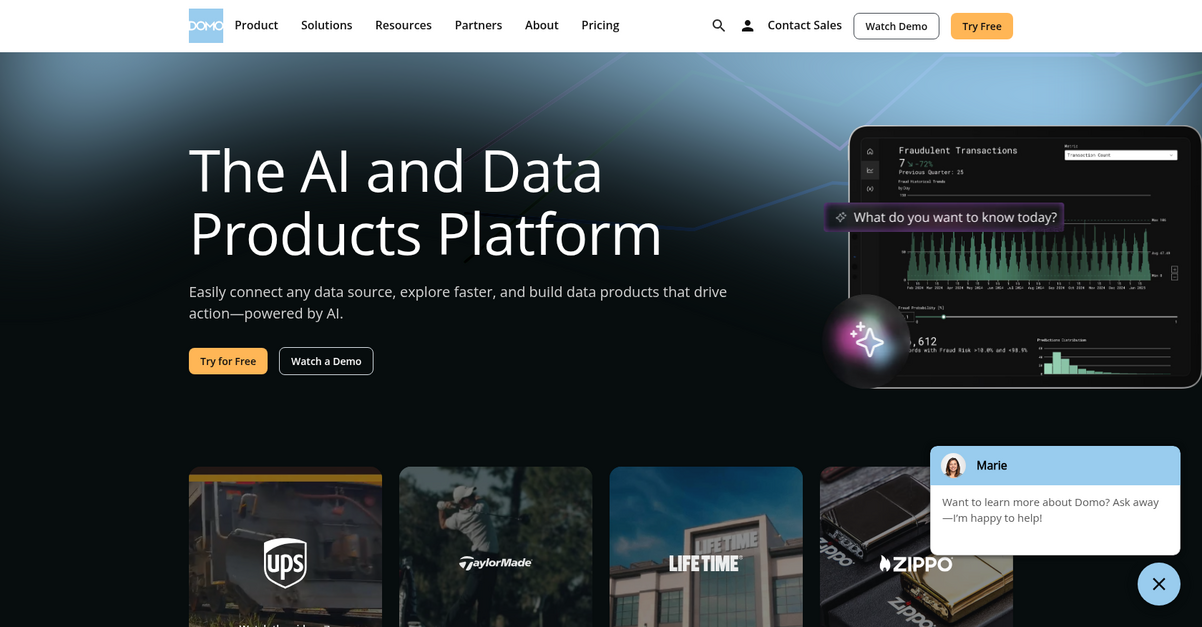
Struggling to command your data for smarter decisions?
Domo offers an AI and data products platform designed to help you connect, prepare, and explore data from any source. This means you can build powerful data products to accelerate business-critical insights with AI assistance.
Here’s how it helps: Domo empowers your teams to drive innovation and impact, providing secure and private AI on your do-it-all platform. This platform helps you streamline operations.
Discover your data’s full potential.
Domo helps you start by centralizing and simplifying data access, leveraging powerful ETL capabilities to transform data with ease. This allows you to integrate data from various sources like Salesforce, SAP, and Google Sheets, preparing it for AI interactions. You can also build impactful visualizations and interactive apps, enhanced by AI, which extends the reach of your insights to teams and customers. Domo’s automation capabilities, baked into the core platform, help you stay informed, streamline operations, and empower your organization to work smarter. This allows you to focus on high-impact priorities.
The result? You achieve more with AI experiences.
Key features:
- Data Integration: Connects, centralizes, and prepares your data from any source, including popular connectors like Salesforce, Excel, and MySQL, ensuring a reliable foundation for analysis.
- Business Intelligence: Enables instant discovery and sharing of insights through powerful visualizations, charts, and dashboards, making data accessible and actionable for all users.
- Intelligent Automation: Utilizes AI agents and no-code workflows to automate tasks, accelerate decision-making, and reduce costly errors, allowing you to focus on high-impact initiatives.
Domo features, pricing, & alternatives →
Verdict: Domo stands out as a strong contender for best dashboard software by addressing data fragmentation and manual reporting pain points. Its comprehensive AI-powered platform with robust integration, intelligent automation, and secure data products empowers operations managers and analytics leads to drive smarter, data-driven decisions and achieve measurable time and cost savings.
2. Tableau

Struggling to make sense of your scattered data?
Tableau helps you turn raw data into trusted insights with its visual analytics platform, enabling you to see, understand, and act on your data.
This means you can transform how your team solves problems with data, moving beyond basic reports to deeply understand your business. Here’s how.
Unlock faster data, insights, and action.
Tableau’s intuitive products ensure data analysis is about asking questions, not wrestling with software. It provides limitless data exploration with built-in visual best practices, without interrupting your flow of analysis.
Additionally, Tableau integrates fully with AI/ML capabilities, data management, and visual storytelling, making data-driven decisions accessible to everyone in your organization. Plus, with options for cloud or on-premises deployment, it truly is the world’s broadest analytics platform.
The result is increased efficiency and productivity.
While we’re discussing data and insights, understanding best graph database platform can further boost your data connections.
Key features:
- AI-powered insights: Level up your analytics and accelerate data-driven decisions with a trusted AI assistant for faster data preparation and visualization.
- Comprehensive platform: Deploy Tableau in the cloud or on-premises, connecting to all your data sources with integrated AI/ML, governance, and data management.
- Intuitive visual analytics: Utilize built-in visual best practices for limitless data exploration, transforming how you understand and act on your data.
Tableau features, pricing, & alternatives →
Verdict: Tableau is an excellent choice for best dashboard software, helping operations managers and analytics leads turn trusted insights into autonomous action. It empowers your team to gain strategic clarity, increase efficiency, and achieve measurable value, as seen with KeyBank empowering 10,000 employees and JLR delivering £250M in business value.
3. Klipfolio

Are you struggling with scattered data and outdated reports?
Klipfolio Klips directly connects to hundreds of services and APIs, helping you build highly customizable dashboards for your team.
This means you can automate data retrieval and gain clarity, moving beyond the heavy lifting of spreadsheets to ensure your dashboards truly deliver insights.
Here’s how Klipfolio helps.
Klipfolio offers a complete dashboard solution by automating data management and allowing limitless presentation options. It pulls live data straight from Excel or Sheets, stopping the chase for yesterday’s numbers.
Plus, you can connect directly to over 200 services, from your CRM to Google Ads, ensuring your data stays connected and reliable, whether you use a data warehouse or not.
You get over 30 best-practice visualizations, custom theming, and white-labeling for beautiful dashboards. Klipfolio also supports pixel-level control, drill-down capabilities, and includes features like Klip comments for context, all designed to inspire confident decision-making across your team.
The result is clear visual storytelling for non-technical users.
While we’re discussing enhancing team communication and decision-making, understanding best WhatsApp Business API providers for customer engagement is equally important.
Key features:
- Automated data management: Automatically refreshes data, schedules refreshes, and integrates with dynamic data sources to keep your dashboards current.
- Customizable dashboards: Offers 30+ visualization types, custom theming, white-labeling, and pixel-level control for visually appealing reports.
- Confident decision-making: Provides real-time visualizations built on trusted data, enabling centralized access and team collaboration for informed choices.
Klipfolio features, pricing, & alternatives →
Verdict: If you’re seeking the best dashboard software to automate reporting and centralize KPIs, Klipfolio is an excellent choice. Its ability to connect disparate systems and provide real-time insights, as praised by over 25,000 customers, means your team can achieve smoother workflows and greater productivity.
4. Geckoboard
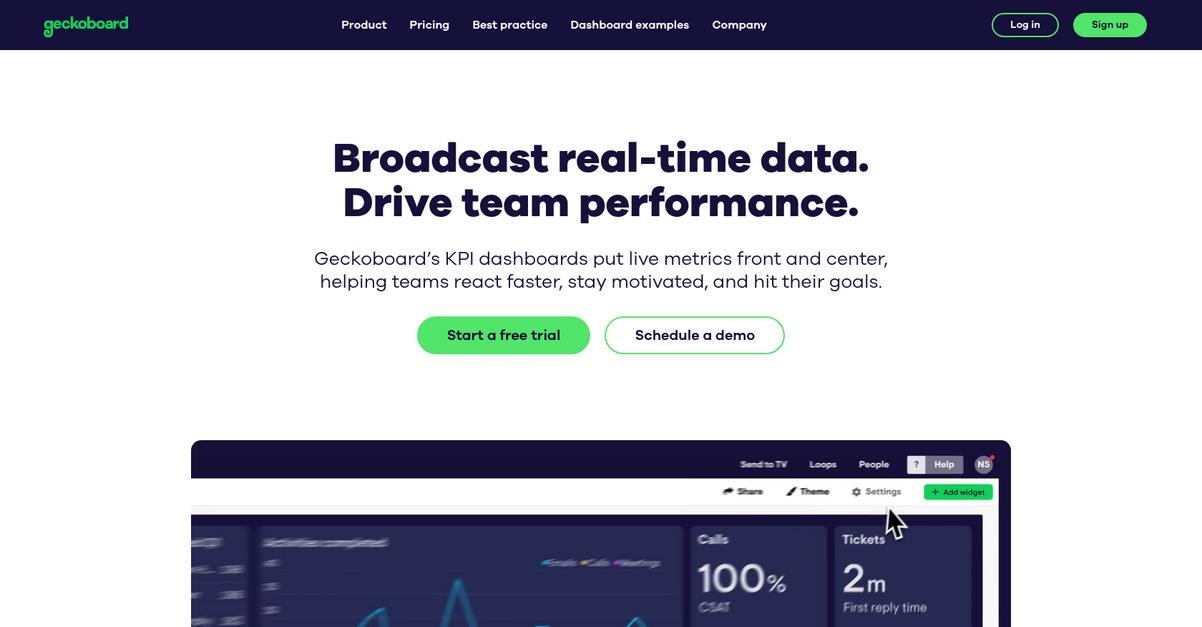
Is scattered data hindering your team’s real-time decisions? Your operations managers and analytics leads understand the struggle of logging into multiple platforms or sifting through endless reports to get a clear picture.
Geckoboard addresses this by providing instant access to live KPI dashboards, centralizing your critical metrics. This means your team can react faster, stay motivated, and ultimately hit their goals without delay.
The dashboard creator and 90+ integrations allow you to build custom dashboards with the exact metrics you need. This ensures you’re always focused on what matters most, eliminating data overload.
Get real-time insights, right now.
Geckoboard helps you unify data from across your business, connecting CRMs, phone systems, ticketing software, and more. This solves the pain point of scattered data sources, making it simple to monitor live data from all your channels.
You can combine live data, balance workloads, and spot areas for improvement, enabling smarter, data-driven decisions. The platform also lets you customize dashboards with your brand colors and logo, making data more engaging for your team.
Additionally, features like KPI notifications and interactive view help make KPIs impossible to miss, allowing you to drill into data for deeper analysis or get instant alerts when key metrics shift. You can display dashboards on office TVs, share links, or access them on mobile devices, ensuring everyone stays informed.
The result is increased team performance and transparency.
Key features:
- Real-time KPI dashboards put live metrics front and center, helping your team react faster and stay motivated by centralizing data from over 90 tools.
- Customizable dashboard creator allows you to build unique dashboards with specific metrics, offering powerful filters and interactive views to dig deeper into performance.
- Multiple sharing options including TV dashboards, shareable links, and mobile access, coupled with scheduled snapshots and custom Slack notifications, ensure KPIs are always visible.
Geckoboard features, pricing, & alternatives →
Verdict: For operations managers and analytics leads seeking the best dashboard software, Geckoboard excels by providing real-time KPI dashboards and over 90 integrations, centralizing crucial data. Its focus on live metrics, customizable views, and effortless sharing capabilities ensures your team can make smarter, data-driven decisions swiftly, enhancing overall productivity and transparency.
5. Databox
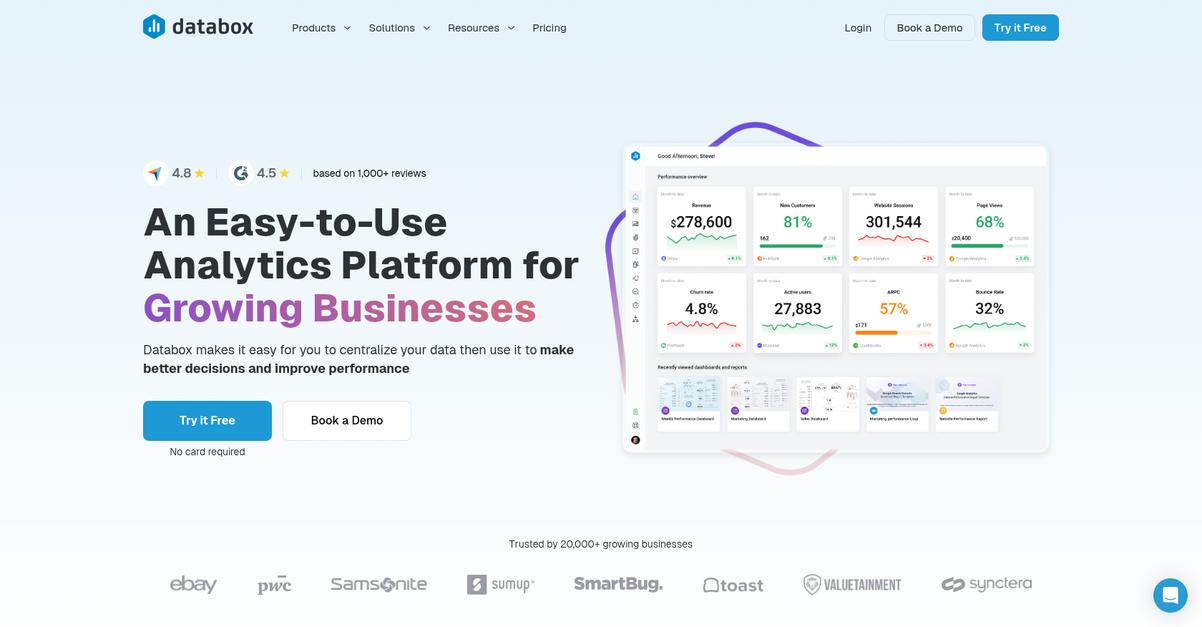
Is your business data scattered and hard to access? This is a common pain point for operations managers and analytics leads, often spending hours manually compiling reports.
Databox addresses this by centralizing your data from hundreds of SaaS applications, databases, APIs, and spreadsheets into one unified source. This means you can finally stop juggling browser tabs and copying screenshots.
You gain a centralized source of truth for your business’s health, allowing your team to get answers on demand. The result? You make better decisions, informed by real data, not hunches.
Here’s how Databox helps.
You can centralize, visualize, analyze, and improve your performance all in one place. Databox makes it simple to track thousands of pre-built metrics and create custom ones by combining multiple metrics.
Plus, you can build beautiful dashboards with a drag-and-drop builder or use 1-click templates to uncover new insights. You can even stream dashboards to a TV or view them on a mobile app. Additionally, the platform allows you to set and track goals, predict future performance with forecasts showing best and worst-case scenarios, and compare your data against thousands of benchmarks to identify improvement opportunities, leading to smarter, data-driven decisions.
Less time reporting, more time on strategy.
While we’re discussing mobile features, you might find my analysis of best mobile marketing platform helpful for your outreach strategies.
Key features:
- Centralized Data Hub: Consolidate data from diverse sources like SaaS applications and spreadsheets, eliminating manual reporting and providing a single source of truth for your team.
- Intuitive Dashboard Creation: Build visually appealing dashboards quickly using a drag-and-drop builder and pre-built templates, enabling clear visibility into company performance and insights.
- Performance Monitoring & Forecasting: Track key metrics, set and monitor goals, predict future performance with forecasting tools, and benchmark against similar companies to drive continuous improvement.
Databox features, pricing, & alternatives →
Verdict: For operations managers and analytics leads at growing mid-sized companies, Databox is the best dashboard software. It excels by centralizing scattered data, automating reporting, and offering intuitive dashboards with forecasting and benchmarking capabilities. The platform’s ease of use and ability to turn data chaos into a clear, centralized view, as seen with customers like Elevate.io, ensures smarter, data-driven decisions and visible ROI for leadership.
6. Wrike
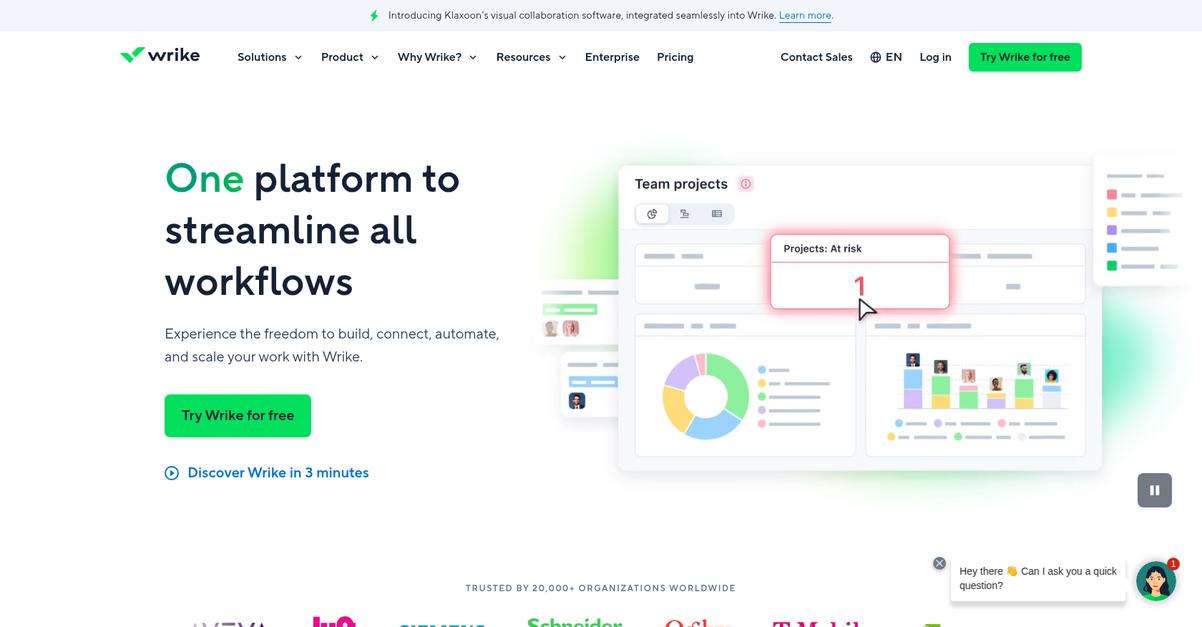
Struggling with scattered data and endless reporting?
Wrike offers powerful analytics and customizable dashboards to fuel faster, data-driven decisions. This means you can centralize your KPIs and gain a 360° view of your projects.
You’ll appreciate how Wrike helps you transform manual processes into automated, interconnected workflows, driving unparalleled productivity and alignment across your teams. This is how work truly flows.
Here’s how Wrike delivers.
Wrike empowers you to build, connect, automate, and scale your work, providing optimal visibility across all projects and departments. This is critical for improving reporting and decision processes, centralizing your data.
You can streamline tasks, leverage interactive Gantt charts for scheduling, and utilize resource management to view team workloads and avoid burnout. Wrike’s AI-driven analytics predict risk and optimize resource allocation, ensuring you’re always on track. Additionally, Wrike integrates with essential tools like Salesforce, Tableau, and MS Excel, allowing you to sync data fast and automate workflows without switching apps.
Plus, you get advanced analytics, proofing, and approvals, all within a secure, customizable environment that supports any team size, from marketing to operations.
Make smarter, data-driven decisions.
Speaking of managing diverse data and making informed decisions, my article on best crypto portfolio management software offers insights into a specialized area.
Key features:
- AI-driven dashboards: Provides powerful analytics for real-time reporting and data-driven insights, helping you predict risk and allocate resources effectively for smarter decisions.
- Workflow automation: Automates repetitive tasks and processes, linking cross-functional teams to drive unparalleled productivity and visibility across your entire organization.
- Extensive integrations: Connects seamlessly with essential business tools like Salesforce, Tableau, Microsoft Excel, and many others, centralizing your data and automating workflows.
Wrike features, pricing, & alternatives →
Verdict: Wrike stands out as a strong contender for best dashboard software, offering comprehensive solutions for operations managers and analytics leads to centralize KPIs and automate reporting. Its AI-driven analytics, customizable dashboards, and extensive integrations empower data-driven decisions, streamline workflows, and ensure higher team productivity.
7. ClickUp
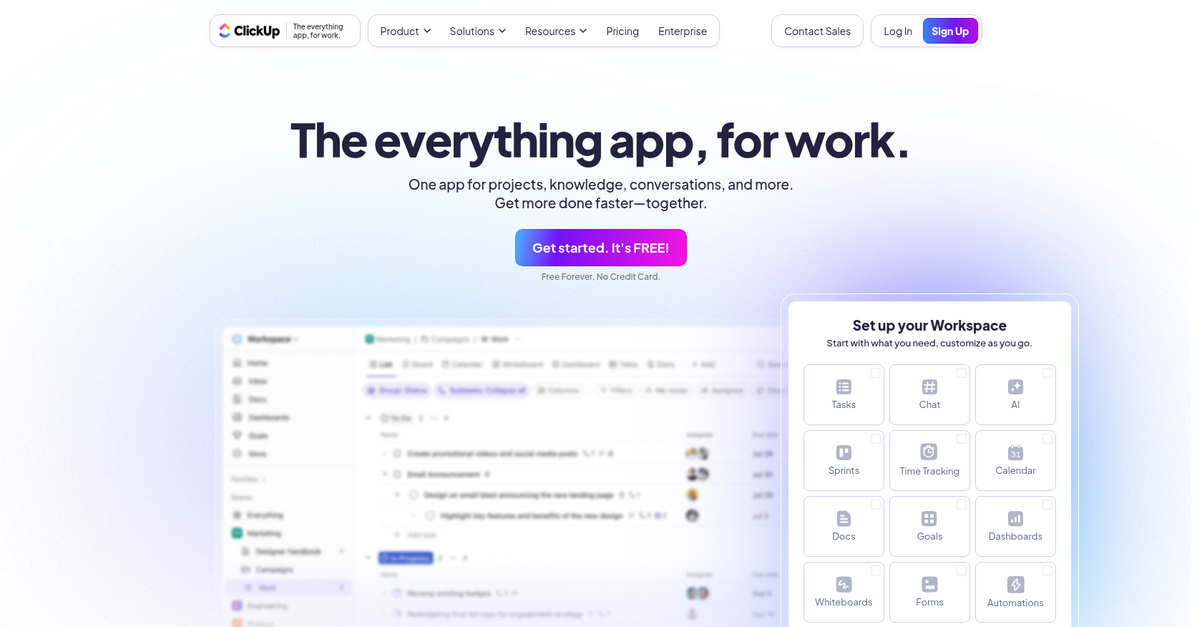
Struggling to command your data and sharpen decisions?
ClickUp offers dashboards alongside features like Tasks, Chat, Docs, and Calendars to align your team and centralize work. This integrated approach tackles scattered data sources and fragmented workflows.
It’s designed to boost productivity and save your teams a day every week. This means you can consolidate projects, knowledge, and conversations into one application, making everything just click.
Let’s fix your broken workflows.
ClickUp allows you to centralize key performance indicators (KPIs) and automate reporting by converging over 50 different apps into one all-in-one workspace. You can instantly switch between 15 views, including list, board, and Gantt.
You can also customize your experience by easily configuring ClickUp for different work types, whether you’re launching campaigns or maintaining flawless operations. This flexibility enables smarter, data-driven decisions and visible ROI for leadership. Plus, their powerful AI, ClickUp Brain, connects every aspect of your work, including searching across all your apps from one place like Google Drive and Salesforce.
The result is increased productivity.
Key features:
- Dashboards and Reporting: Provides robust dashboards and reporting capabilities to centralize KPIs and gain real-time insights for data-driven decisions.
- Unified Workspace: Consolidates tasks, documents, chats, and goals into one application, eliminating app-switching and improving team alignment and collaboration.
- AI and Integrations: Leverages AI for smarter workflows and offers extensive integrations with over 50 popular business tools, streamlining processes and automating tasks.
ClickUp features, pricing, & alternatives →
Verdict: ClickUp’s comprehensive features, including integrated dashboards and AI capabilities, make it an excellent choice for the best dashboard software, helping your mid-sized company achieve smoother workflows and higher team productivity, ultimately saving measurable time and costs, as one team reduced project delay by over 70%.
Conclusion
Stop guessing with outdated reports.
Choosing the right dashboard is a huge challenge. With data scattered across countless apps, getting a single, clear view of your operations feels impossible.
This isn’t just an inconvenience for your team. Making critical decisions with incomplete data leads to missed targets, costly operational errors, and strategic plans that can set your entire business back months.
Here’s what I recommend.
From everything I’ve reviewed, Domo is the clear standout. It directly solves this problem by centralizing your data and automating reporting from any source.
Its secure, AI-powered platform not only visualizes your data but helps you build powerful apps to streamline operations. This is why I consider it the best dashboard software.
If you’re also looking into other specialized business tools, my article on best online food ordering software covers a vital area.
I highly recommend you start a free trial of Domo. See for yourself how it can transform your reporting and unlock actionable insights.
You’ll make smarter decisions, faster.
